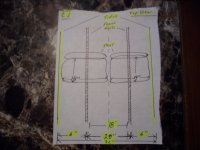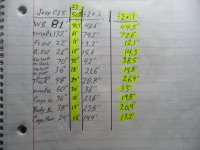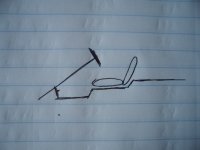Functional Artist
Well-known member
For my next creation, I've been thinking about building a go kart sized jeep (mini-Jeep)
...but first, here is some Jeep info.
"The Jeep marque has been headquartered in Toledo, Ohio, ever since Willys–Overland launched production of the first CJ or Civilian Jeep branded models there in 1945. Its replacement, the conceptually consistent Jeep Wrangler series, remains in production since 1986. With its solid axles and open top, the Wrangler is the Jeep model that is central to the brand's identity.
At least two Jeep models (the CJ-5 and the SJ Wagoneer) enjoyed extraordinary three-decade production runs of a single body generation.
In lowercase, the term "jeep" continues to be used as a generic term for vehicles inspired by the Jeep that are suitable for use on rough terrain. In Iceland, the word Jeppi (derived from Jeep) has been used since WWII and is still used for any type of SUV.
Prior to 1940 the term "jeep" had been used as U.S. Army slang for new recruits or vehicles, but the World War II "jeep" that went into production in 1941 specifically tied the name to this light military 4x4, arguably making them the oldest four-wheel drive mass-production vehicles now known as SUVs. The Jeep became the primary light 4-wheel-drive vehicle of the United States Armed Forces and the Allies during World War II, as well as the postwar period. The term became common worldwide in the wake of the war. Doug Stewart noted: "The spartan, cramped, and unstintingly functional jeep became the ubiquitous World War II four-wheeled personification of Yankee ingenuity and cocky, can-do determination." It is the precursor of subsequent generations of military light utility vehicles such as the Humvee, and inspired the creation of civilian analogs such as the original Series I Land Rover. Many Jeep variants serving similar military and civilian roles have since been designed in other nations.
Probst drafted the full plans in just two days for the Bantam prototype known as the BRC or Bantam Reconnaissance Car, working up a cost estimate the next day. Bantam's bid was submitted on July 22, complete with blueprints. Much of the vehicle could be assembled from off-the-shelf automotive parts, and custom four-wheel drivetrain components were to be supplied by Spicer. The hand-built prototype was completed in Butler, Pennsylvania and driven to Camp Holabird, Maryland on September 23 for Army testing. The vehicle met all the Army's criteria except engine torque.
The Army thought that the Bantam company lacked the production capacity to manufacture and deliver the required number of vehicles, so it supplied the Bantam design to Willys and Ford, and encouraged them to enhance the design. The resulting Ford "Pygmy" and Willys "Quad" prototypes looked very similar to the Bantam BRC prototype, and Spicer supplied very similar four-wheel drivetrain components to all three manufacturers.
1,500 of each model (Bantam BRC-40, Ford GP, and Willys MA) were built and extensively field-tested. After the weight specification was revised, Willys-Overland's chief engineer Delmar "Barney" Roos modified the design in order to use Willys's heavy but powerful "Go Devil" engine, and won the initial production contract. The Willys version became the standard jeep design, designated the model MB, and was built at their plant in Toledo, Ohio. The familiar pressed-metal Jeep grille was a Ford design feature and incorporated in the final design by the Army.
Because the US War Department required a large number of vehicles in a short time, Willys-Overland granted the US Government a non-exclusive license to allow another company to manufacture vehicles using Willys' specifications. The Army chose Ford as a second supplier, building Jeeps to the Willys' design. Willys supplied Ford with a complete set of plans and specifications. American Bantam, the creators of the first Jeep, built approximately 2,700 of them to the BRC-40 design, but spent the rest of the war building heavy-duty trailers for the Army.
Final production version jeeps built by Willys-Overland were the Model MB, while those built by Ford were the Model GPW (G = government vehicle, P = 80" wheelbase, W = Willys engine design). There were subtle differences between the two. The versions produced by Ford had every component (including bolt heads) marked with an "F", and early on Ford also stamped their name in large letters in their trademark script, embossed in the rear panel of their jeeps. Willys followed the Ford pattern by stamping 'Willys' into several body parts, but the U.S. government objected to this practice, and both parties stopped this in 1942.
The cost per vehicle trended upwards as the war continued from the price under the first contract from Willys at US$648.74 (Ford's was $782.59 per unit).[27] Willys-Overland and Ford, under the direction of Charles E. Sorensen (vice-president of Ford during World War II), produced about 640,000 Jeeps.
Jeeps were used by every service of the U.S. military. An average of 145 were supplied to every Army infantry regiment. Jeeps were used for many purposes, including cable laying, Sawmilling, as firefighting pumpers, field ambulances, tractors, and, with suitable wheels, would run on railway tracks."
https://en.wikipedia.org/wiki/Jeep
So, I've been lookin' at this:
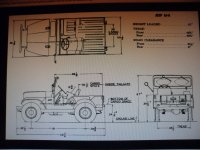 So, Ima thinkin' probably ~1/2 size, (~0.5), ~50% or ~2:1 reduction
So, Ima thinkin' probably ~1/2 size, (~0.5), ~50% or ~2:1 reduction
Maybe something like this
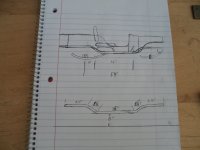
...but first, here is some Jeep info.
"The Jeep marque has been headquartered in Toledo, Ohio, ever since Willys–Overland launched production of the first CJ or Civilian Jeep branded models there in 1945. Its replacement, the conceptually consistent Jeep Wrangler series, remains in production since 1986. With its solid axles and open top, the Wrangler is the Jeep model that is central to the brand's identity.
At least two Jeep models (the CJ-5 and the SJ Wagoneer) enjoyed extraordinary three-decade production runs of a single body generation.
In lowercase, the term "jeep" continues to be used as a generic term for vehicles inspired by the Jeep that are suitable for use on rough terrain. In Iceland, the word Jeppi (derived from Jeep) has been used since WWII and is still used for any type of SUV.
Prior to 1940 the term "jeep" had been used as U.S. Army slang for new recruits or vehicles, but the World War II "jeep" that went into production in 1941 specifically tied the name to this light military 4x4, arguably making them the oldest four-wheel drive mass-production vehicles now known as SUVs. The Jeep became the primary light 4-wheel-drive vehicle of the United States Armed Forces and the Allies during World War II, as well as the postwar period. The term became common worldwide in the wake of the war. Doug Stewart noted: "The spartan, cramped, and unstintingly functional jeep became the ubiquitous World War II four-wheeled personification of Yankee ingenuity and cocky, can-do determination." It is the precursor of subsequent generations of military light utility vehicles such as the Humvee, and inspired the creation of civilian analogs such as the original Series I Land Rover. Many Jeep variants serving similar military and civilian roles have since been designed in other nations.
Development – 1. Bantam Reconnaissance Car
When it became clear that the United States would be involved in the European theater of World War II, the Army contacted 135 companies to create working prototypes of a four-wheel drive reconnaissance car. Only two companies responded: American Bantam Car Company and Willys-Overland. The Army set a seemingly impossible deadline of 49 days to supply a working prototype. Willys asked for more time, but was refused. American Bantam had only a small staff with nobody to draft the vehicle plans, so chief engineer Harold Crist hired Karl Probst, a talented freelance designer from Detroit. After turning down Bantam's initial request, Probst responded to an Army request and began work on July 17, 1940, initially without salary.Probst drafted the full plans in just two days for the Bantam prototype known as the BRC or Bantam Reconnaissance Car, working up a cost estimate the next day. Bantam's bid was submitted on July 22, complete with blueprints. Much of the vehicle could be assembled from off-the-shelf automotive parts, and custom four-wheel drivetrain components were to be supplied by Spicer. The hand-built prototype was completed in Butler, Pennsylvania and driven to Camp Holabird, Maryland on September 23 for Army testing. The vehicle met all the Army's criteria except engine torque.
Development – 2. Willys and Ford
The Army thought that the Bantam company lacked the production capacity to manufacture and deliver the required number of vehicles, so it supplied the Bantam design to Willys and Ford, and encouraged them to enhance the design. The resulting Ford "Pygmy" and Willys "Quad" prototypes looked very similar to the Bantam BRC prototype, and Spicer supplied very similar four-wheel drivetrain components to all three manufacturers.
1,500 of each model (Bantam BRC-40, Ford GP, and Willys MA) were built and extensively field-tested. After the weight specification was revised, Willys-Overland's chief engineer Delmar "Barney" Roos modified the design in order to use Willys's heavy but powerful "Go Devil" engine, and won the initial production contract. The Willys version became the standard jeep design, designated the model MB, and was built at their plant in Toledo, Ohio. The familiar pressed-metal Jeep grille was a Ford design feature and incorporated in the final design by the Army.
Because the US War Department required a large number of vehicles in a short time, Willys-Overland granted the US Government a non-exclusive license to allow another company to manufacture vehicles using Willys' specifications. The Army chose Ford as a second supplier, building Jeeps to the Willys' design. Willys supplied Ford with a complete set of plans and specifications. American Bantam, the creators of the first Jeep, built approximately 2,700 of them to the BRC-40 design, but spent the rest of the war building heavy-duty trailers for the Army.
Final production version jeeps built by Willys-Overland were the Model MB, while those built by Ford were the Model GPW (G = government vehicle, P = 80" wheelbase, W = Willys engine design). There were subtle differences between the two. The versions produced by Ford had every component (including bolt heads) marked with an "F", and early on Ford also stamped their name in large letters in their trademark script, embossed in the rear panel of their jeeps. Willys followed the Ford pattern by stamping 'Willys' into several body parts, but the U.S. government objected to this practice, and both parties stopped this in 1942.
The cost per vehicle trended upwards as the war continued from the price under the first contract from Willys at US$648.74 (Ford's was $782.59 per unit).[27] Willys-Overland and Ford, under the direction of Charles E. Sorensen (vice-president of Ford during World War II), produced about 640,000 Jeeps.
Jeeps were used by every service of the U.S. military. An average of 145 were supplied to every Army infantry regiment. Jeeps were used for many purposes, including cable laying, Sawmilling, as firefighting pumpers, field ambulances, tractors, and, with suitable wheels, would run on railway tracks."
https://en.wikipedia.org/wiki/Jeep
So, I've been lookin' at this:
 So, Ima thinkin' probably ~1/2 size, (~0.5), ~50% or ~2:1 reduction
So, Ima thinkin' probably ~1/2 size, (~0.5), ~50% or ~2:1 reduction Maybe something like this












